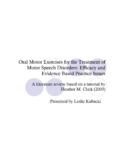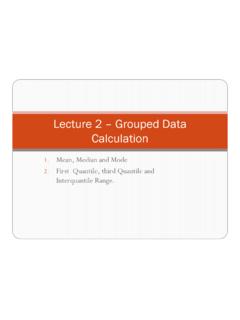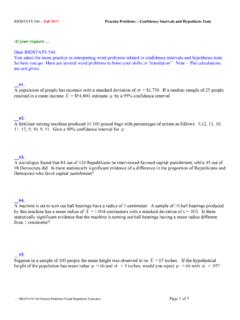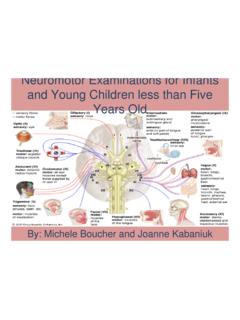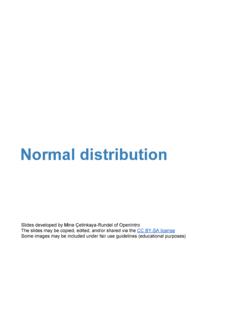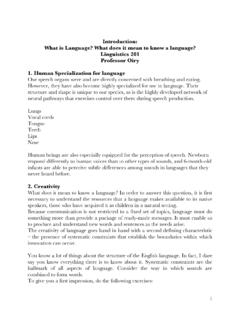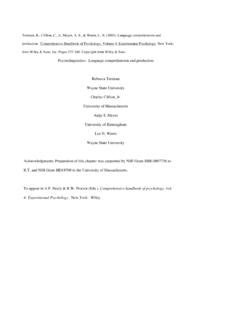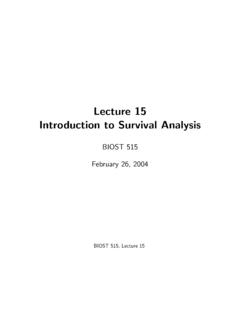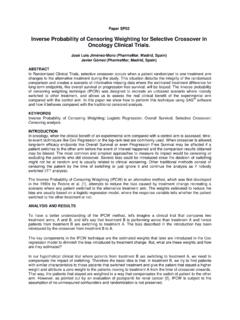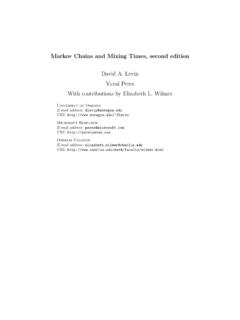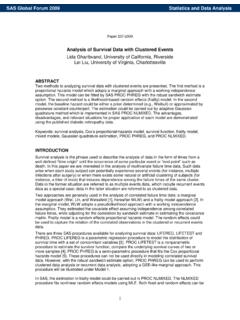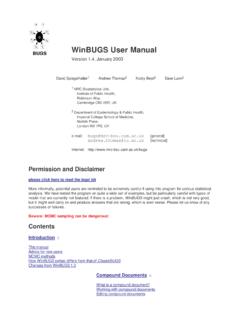Transcription of Unit 8. Introduction to Survival Analysis - UMass
1 BIOSTATS 640 Spring 2020 8. Introduction to Survival Analysis - R Users Page 1 of 53 Nature Population/ Sample Observation/ Data Relationships/ Modeling Analysis / Synthesis Unit 8. Introduction to Survival Analysis Another difficulty about statistics is the technical difficulty of calculation. Before you can even make a mistake in drawing your conclusion from the correlations established by your statistics, you must ascertain the correlations. - George Bernard Shaw Censored data is tricky. Suppose you are interested in studying Survival following heart transplant surgery. A comparison group might be similarly sick patients who do not undergo transplant surgery.
2 All other things being equal, do surgically treated patients have longer Survival times than non-surgically treated patients? How to proceed? One approach might be to do a logistic regression Analysis with outcome defined as 0/1 occurrence of death by 1 year. Or 5 years. Or 10 years. A limitation of this approach is the possibility of loss to follow-up. At the end of your study, some study participants will have died. Others will have been lost to follow up. And still others will be known to be alive at last contact. In some instances you have complete information (eg; a study subject is known to have died at years post transplant). In other instances, only partial information is known (eg; another study subject is known to have survived years but there is no additional information).
3 Data such as these are known as Survival data and special techniques are required for their Analysis . Fortunately, they exist! They have the advantage of taking into consideration the available information on every subject (so much better than tossing these observations out!). The Survival analyses introduced in this unit are used to address questions such as the following: 1. What is the estimated probability of subject surviving a specified amount of time? (eg; what is the five-year Survival rate?) 2. What is the comparative Survival experience of two independent groups of subjects? (eg; relative to standard care, is heart transplant surgery associated with a statistically significant improvement in Survival ?)
4 3. Among possibly multiple indicators of risk (eg age, comorbidities), which are statistically significantly associated with greater hazard of event (eg; what are the risk factors for poor prognosis following heart transplant surgery?) BIOSTATS 640 Spring 2020 8. Introduction to Survival Analysis - R Users Page 2 of 53 Nature Population/ Sample Observation/ Data Relationships/ Modeling Analysis / Synthesis Table of Contents Topic Learning Objectives .. 1. Introduction and Examples .. 2. Example 1 Survival Following a Heart 3. Notation and Definitions .. 4. Probability Models for Survival Data .. 5. The Kaplan-Meier Curve - Model Free Estimation.
5 6. The Log Rank and Related Tests -Model Free Comparison: .. 7. Introduction to the Cox PH Model .. 8. Interpretation of a Cox PH 9. Hypothesis Testing Using the Cox PH Model .. 10. Evaluating the Proportional Hazards Assumption .. 11. Regression Diagnostics for the Cox PH Model .. 3 4 11 14 19 22 30 37 39 43 45 48 Appendix Overview of Maximum Likelihood Estimation of a Cox PH Model .. 50 BIOSTATS 640 Spring 2020 8. Introduction to Survival Analysis - R Users Page 3 of 53 Nature Population/ Sample Observation/ Data Relationships/ Modeling Analysis / Synthesis Learning Objectives When you have finished this unit, you should be able to: Explain time-to-event data and provide examples.
6 Define censoring and explain the three kinds of censoring : right censored, left censored and interval censored. Calculate Kaplan-Meier estimates of Survival probabilities for a single sample of time-to-event data with right censoring . Draw a Kaplan-Meier curve of estimated Survival probabilities for a single sample of time-to-event data with right censoring . State the null hypothesis of the log-rank test. Perform and interpret the log-rank test for the comparison of the Survival experience of two independent groups in the setting of right censoring . Explain the idea of the hazard ratio and its similarity to the idea of relative risk. Define the Cox Proportional Hazards (PH) model. Extract point and confidence interval estimates of relative hazard (hazard ratio) from a fitted Cox PH model.
7 Interpret the results of a Cox PH model Analysis that examines the nature and significance of possibly multiple predictors of Survival . BIOSTATS 640 Spring 2020 8. Introduction to Survival Analysis - R Users Page 4 of 53 Nature Population/ Sample Observation/ Data Relationships/ Modeling Analysis / Synthesis 1. Introduction and Examples The type of data that is of interest here is different from those that we have considered previously. In BIOSTATS 540: A sample of observations of a continuous variable ( blood pressure, cholesterol) that is distributed Normal. In BIOSTATS 540: Two independent samples of observations of a continuous variable ( blood pressure, cholesterol), one from each of two groups (the groups might have been males and females or controls and experimentals) that are distributed Normal.
8 In BIOSTATS 540: One or two observations of discrete (in particular, count) data that is distributed Binomial ( # heads in several tosses of a coin, # remissions of cancer among several persons treated with a new cancer therapy). In BIOSTATS 640: Paired observations of two discrete traits ( race/ethnicity and religious affiliation) each of which has multiple possibilities ( race/ethnicity might be coded as African/American, Latino, Asian, Other and religious affiliation might be coded as Muslim, Hindu, Judao/Christian, Other) and which we analyze using contingency table approaches. In BIOSTATS 640: Observations of a normally distributed variable ( blood pressure, cholesterol) which we investigate in relationship to a collection of hypothesized predictors ( age, sex, health behaviors) using multivariable normal theory regression techniques (Unit 5).
9 In BIOSTATS 640: Observations of a Bernoulli distributed binary discrete variable ( yes/no disease) which we investigate in relationship to a collection of hypothesized predictors ( exposure, age, sex, health behaviors) using multivariable logistic regression techniques (Unit 7). BIOSTATS 640 Spring 2020 8. Introduction to Survival Analysis - R Users Page 5 of 53 Nature Population/ Sample Observation/ Data Relationships/ Modeling Analysis / Synthesis Consider the following settings. A cancer study examines the time from onset of therapy to death. The goal is a descriptive one directed to an understanding of prognosis. A study of treatments for cardiovascular disease compares bypass surgery, angioplasty and medical therapy by examining the time from treatment until death.
10 The setting is a randomized controlled trial with the objective of assessing the relative benefits of three alternative management approaches. A health services researcher might seek a description of the patterns of time from enrollment in a health plan to first utilization of services. The setting is health services planning. In these settings, the focus is on a special type of continuous variable known as time to event data. Time to event data are such things as length of time unemployed - measured from date of layoff lifetime of a light bulb ( failure time data). elapsed time to death following diagnosis of disease ( Survival time data). A characteristic of time to event data is that it may (and often does) include observations that are incomplete.
